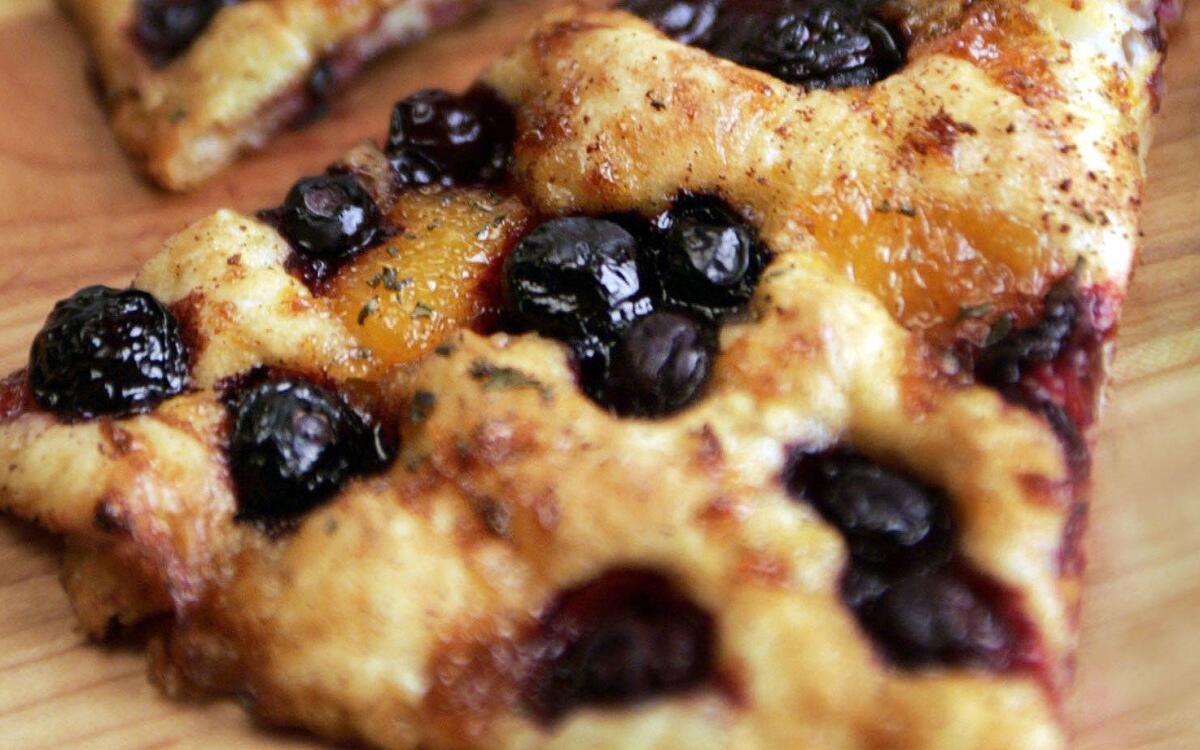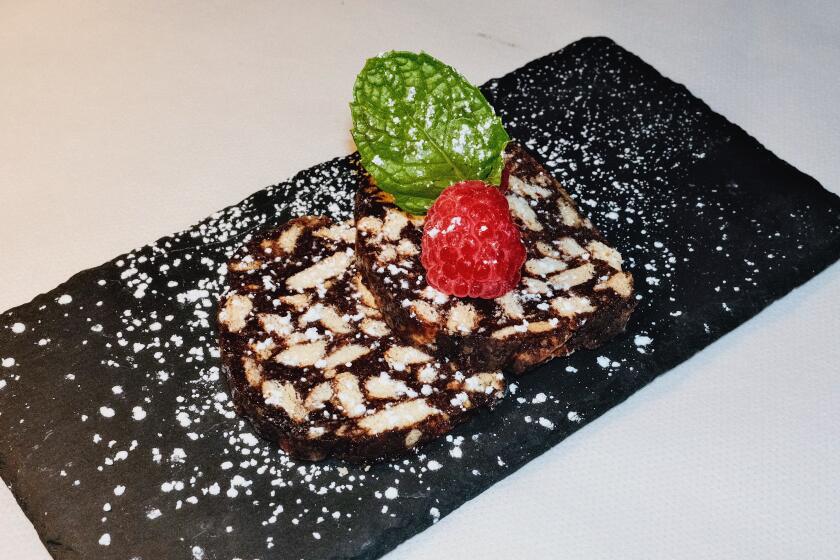Blueberry and caramelized orange marmalade focaccia

- Share via
Pity the poor blueberry.
Often it gets lost in the mix, thrown in among brighter, showier berries, or overlooked simply because it seems to be around all the time. It’s not exactly the most outgoing of berries either, with its broodily dark color and subtle flavor.
But with a trick or two in the kitchen, you can coax this shy berry to shine and even sing. And if you keep an eye out for locally grown ones, you’ll hardly have to nudge them and you will wonder why you hadn’t been paying attention to them all along.
Once they’re picked, blueberries are as ripe as they’ll get. So local ones, which have a shorter distance to travel to market, are likelier to be more flavorful than those imported throughout the year from out of state or even out of the country. In Southern California, blueberries thrive in farms along the coast, thanks to a combination of microclimate and cultivation.
It’s a relatively long local season, starting as early as January and stretching into September, with varying degrees of abundance and flavor depending on the weather. A hot spell can cut short a good cycle. Perfect warm-and-cool conditions can mean a blueberry bonanza. We’re teetering somewhere in between those two now. So if you haven’t been out and about, grabbing them while you can at farmers markets, you’d better hurry.
Pastry chef Dorte Lambert wastes no time. “We go and taste at every stand and buy what’s best,” says Lambert, a consultant at Michael’s restaurant in Santa Monica, where she was one of the original pastry chefs.
For her browned-butter tart, which has been on Michael’s menu since the restaurant’s early days in the 1980s, she likes blueberries that are crisp and tart.
The berries are scattered within the delicious browned-butter filling that forms a thin top crust as it bakes. “The butter has to be almost burned -- that creates that nutty flavor,” Lambert says. “If you don’t really bring it to the edge, you just have boring sweet butter.”
Nothing’s boring about this tart, from the crisp crust made with an egg yolk and a touch of cream, to its crowning glory: a heap of glistening blueberries that have been blanched in a simple syrup to bring out their best flavor.
Elizabeth Belkind, pastry chef at Grace, recently served a peach and caramelized apricot jam focaccia on a tasting menu. But the idea goes back to a blueberry-orange version she created for a housewarming brunch last year.
It starts with a dough that, unlike most focaccias, is enriched with butter and thus bakes softer. Then for the topping, Belkind also brings together browned butter and blueberries, but takes that toasted flavor to another level, adding a divine caramelized orange marmalade.
Alan Ashkinaze, chef at Aqua at St. Regis Monarch Beach Resort, recently offered as an amuse a chilled watermelon soup with blueberries. You could also think of it as a fruity aperitif (it’s got a splash of Champagne and touch of orange liqueur), or serve it as a cocktail at a casual brunch (think mimosa) or a palate cleanser for a fancy dinner.
For Ashkinaze, it was a serendipitous soup. “We had a lot of watermelon and a lot of blueberries,” says the chef, who often buys produce from a roving farmer who delivers to his door. “And the blueberries were phenomenal. They were a touch overripe, so they went into a soup.”
You can make the soup base ahead and chill it till you’re ready to serve. When you pour it over, a couple of the blueberries might float to the top, but most will stay below, like little treasures waiting to be discovered.
Caramelized orange marmalade
With a sharp paring knife, slice the top and bottom off each orange. Then, cut off the peel and pith in swift downward curves, exposing the pulp. Hold the peeled orange over a bowl to catch any juices and cut out the segments by wedging the knife next to the connective membranes on both sides of each segment. You will need 2 cups of fruit with no pith or membrane attached.
Strain out half a cup of the orange segments and set aside. Leave the remaining 1 1/2 cups of the segments with the juice.
Combine the sugar with the water in a heavy-bottomed nonreactive saucepan, stirring until the mixture resembles wet sand. Add the vanilla bean and seeds. Using a pastry brush or clean fingers, brush down any stray sugar granules on the sides of the pan to prevent the mixture from crystallizing as it caramelizes.
Set the pan over high heat and cook the mixture, undisturbed. When it begins to brown, gently swirl and continue cooking until the sugar turns a deep golden brown, 8 to 10 minutes. Add 1 1/2 cups of the orange segments and all of the reserved juice (be careful; the hot caramel will spatter as you do this). Once the spattering subsides, stir the mixture quickly and continuously with a wooden spoon until the marmalade begins to thicken and the bubbles are thick and glossy, about 8 minutes.
Add the bourbon, if using, and continue stirring vigorously until the alcohol dissipates, 2 minutes. Add the remainder of the orange segments and stir gently, just until the last of the fruit reaches the same temperature as the marmalade, about 1 minute. Remove from the heat. Discard the vanilla bean. Transfer the marmalade to a flat container with low sides and spread it out as thinly as possible. Cool the mixture and cover the container with plastic wrap and set aside. (Makes 1 1/3 cups marmalade.)
Focaccia
Cut the 7 tablespoons of butter into half-inch cubes and set aside, letting them soften. In a small saute pan, combine the 1 1/2 sticks of butter with the vanilla bean and seeds. Over medium-low heat, melt the butter and cook until it begins to bubble and brown. Gently stir, scraping the bottom of the pan. When you see rust-colored specks in the bubbles, the browned butter is done, about 7 minutes. Immediately transfer it to a small bowl and set aside.
Place the yeast into the bowl of an electric mixer. Add the water and whisk to dissolve the yeast. Stir in the granulated sugar. Add the pastry flour, bread flour, nonfat dry milk and salt. Using the dough-hook attachment, mix on low about 2 minutes, scraping the sides and bottom of the bowl if needed. Turn the speed up to medium and knead the dough for 6 minutes. Add the cubed, softened butter and continue kneading until the butter is completely incorporated. (The dough will be soft.)
Brush a clean, large bowl with a generous amount of the browned butter. Scrape the dough out of the mixing bowl and into the buttered bowl. Gently brush the top of the dough with more of the brown butter. Cover the bowl tightly with plastic wrap. Set it in a warm place and allow the dough to rise until it doubles, about 45 minutes.
Heat the oven to 400 degrees. Line two baking sheets with parchment paper; grease with browned butter. Brush a cutting board with a small amount of browned butter. Turn the dough out onto the board. Using a pastry scraper, halve the dough and scoop each half onto a baking sheet. Using the palms of your hands and your fingertips, flatten the dough, starting at the center, and coax it into a 10-inch circle with edges slightly higher than the center. Gently brush the dough with browned butter again. Lightly cover the dough with a clean, damp kitchen towel and set in a warm place for 30 minutes. When the dough has risen, gently press your fingertips to form dimples all over the surface. Brush with the rest of the brown butter.
Sprinkle half of the raw sugar over each of the focaccia rounds. Gently and generously brush about half of the caramelized orange marmalade over each round (you may have a tablespoon or two left over), then sprinkle with half of the blueberries and half of the rosemary. Bake 15 to 20 minutes, rotating the baking sheets 180 degrees halfway through to allow for even browning. When done, the top of the focaccia will be soft to the touch.
Cool for about 10 minutes. Cut each focaccia into 10 wedges. Serve warm.
Get our Cooking newsletter
Get a taste of Los Angeles — and the world — with recipes and kitchen tricks from the L.A. Times’ Cooking newsletter.
You may occasionally receive promotional content from the Los Angeles Times.















